
6 minute read
HERITAGE & ARCHITECTURE
HERITAGE & ARCHITECTURE BRADFORD
The City of Bradford has a fascinating history, growing from a small rural settlement to an industrial powerhouse dubbed the ‘Wool Capital of the World’ in the Victorian era.
Advertisement
‘Broad Ford’, later known as Bradford, was first settled in Saxon times and spent much of its history as a small rural market town of 16,000 people, where wool spinning and cloth weaving was carried out in local cottages and farms.
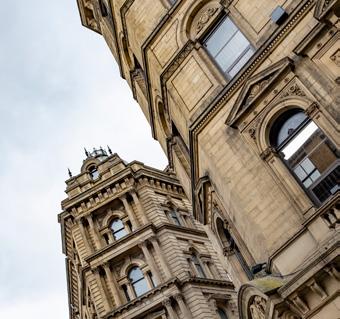
Industrial growth in the 19th Century led to the rapid expansion of the city and between 1800 and 1850 Bradford transformed from a rural town amongst the woods and fields to a sprawling town filling the valley sides. The town centre expanded and its old buildings were largely replaced by new ones with lavish Victorian architecture still much in evidence today.
www.visitbradford.comwww.visitbradford.com By 1841 there were 38 worsted mills in Bradford town and 70 in the borough and it was estimated that two-thirds of the country’s wool production was processed in Bradford. Less than ten years later, Bradford had become the wool capital of the world with a population of 100,000. Bradford was granted city status on 9 June 1897.
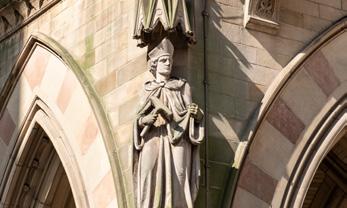
HERITAGE & ARCHITECTURE ILKLEY
Ilkley has a very long history and Ilkley Moor is well known for its archaeology, the town has continued to develop and thrive across the centuries, each era leaving its mark on the town.
On Ilkley Moor there are carvings thought to date from the early Bronze Age, around 1800 BC. There are 400 known ‘cup and ring’ carved stones across the moors, their purpose remains a mystery.
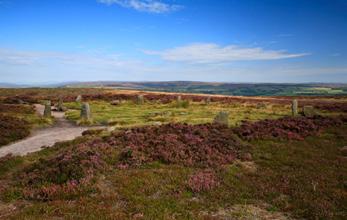
Ilkley rose to fame as a Spa town in the nineteenth-century when thousands - including Charles Darwin - visited for fresh air, good food and the lively social scene. The town is characterised by Victorian architecture with wide streets and floral displays. Grand hydro hotels were developed and wealthy visitors arrived by coach to ‘take the waters’ at White Wells.

Later the Romans were tempted by Ilkley’s riverside charms and established a small fort on the road from York to Manchester, called Olicana. A few remains can be discovered close to the Manor House and adjacent to All Saints Parish Church.
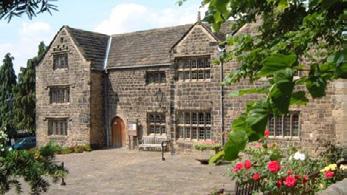
An interesting way to find out about the history of Ilkley is through its blue plaques, look out for them on significant buildings around the town.
HERITAGE & ARCHITECTURE SALTAIRE
Saltaire is named after Titus Salt and the River Aire, which runs through the village. Titus Salt rose from modest beginnings to become one of the country’s most successful industrialists, leaving this fine village as his legacy.
Salt had the village built so that he could make fine wool fabrics using the most efficient methods available and provide a healthy environment for his workers. Saltaire took twenty-five years to complete and began with the building of the Mill in 1851.


Housing compared favourably with the typical worker’s cottage. Each had a water supply, gas lighting, an outdoor privy, separate living and cooking spaces and several bedrooms.

www.visitbradford.comwww.visitbradford.com Lockwood and Mawson designed the entire village in a classical style, inspired by the Italian Renaissance. Their finest work was Saltaire United Reformed Church, now a Grade 1 listed building.
HERITAGE & ARCHITECTURE HAWORTH
On the edge of the Pennines, the Haworth known by the Brontës was a working village, producing worsted yarn and cloth. However the village was soon to become a site of literary pilgrimage, the Brontë Society was founded in 1893 and visitors have made their way to this iconic location ever since.
Brontë Parsonage is the former home of the Brontë family and now open as a museum dedicated to their life and works. St Michael and All Angels Church and churchyard are located next door and from here the church steps lead out onto the Main Street.
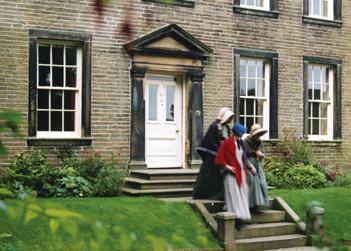
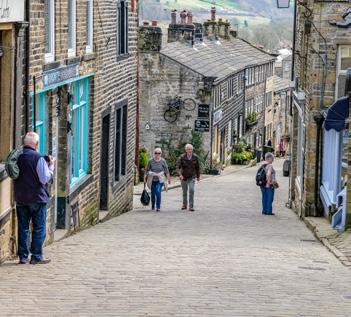
Top Withens is a ruined farmhouse near Haworth, which is said to have been the inspiration for Wuthering Heights, the novel by Emily Brontë.

Haworth’s Main Street is a famous and picturesque cobbled high street. The steep climb takes you past a number of boutique shops, quaint cafés and traditional pubs. The village expanded after the opening of the Keighley and Worth Valley Railway in 1867, and many of the local mills grew into large steam-powered factories. The railway closed in 1962 and was reopened in 1968 as a heritage line, operated by volunteers and is now a popular way to arrive in the village.
HERITAGE & ARCHITECTURE CITY CENTRE HERITAGE TRAIL
Bradford boomed during the industrial revolution becoming the wool capital of the world and one of the most important trading centres in the UK. Its industrial and cultural heritage can still be admired today with a fine collection of heritage buildings dotted around the city centre.
THE MIDLAND HOTEL Built: 1885-1890
A bold and lavish terminus hotel that is best seen from a distance where the roof detailing can be appreciated. The many famous names who have stayed here include Laurel and Hardy, The Beatles and the Rolling Stones.
Forster Square, Cheapside, Bradford BD1 4HU
BRADFORD CATHEDRAL Built: 1400 - 1965
The cathedral dates largely from the 15th century, incorporating a 14th century nave arcade. The parish church was given cathedral status in 1919 and the east end remodelled and extended in 1954-63 by Sir Edward Maufe. It contains some fine stained glass from the William Morris workshop (1862) and other valuable monuments and fittings.
1 Stott Hill, Bradford BD1 4EH
LITTLE GERMANY Built: 1855 - 1890
A compact area of late Victorian warehouses and offices built on a steep slope and having a highly distinctive character of its own. Here merchants could store and sell their goods in their own private premises, rather than through the exchanges. This vast area was developed between 1855 and 1890, the architect for much of it being Eli Milnes (of Milnes and France). It is full of tall, high quality buildings, closely spaced to reduce land purchase costs, and producing some fine streetscapes.
Bradford, BD1
ST. GEORGE’S HALL Built: 1851 - 1853
Built in 1851-53 and the first major public building by Lockwood and Mawson. It is a truly grand building, designed as a classical temple on a podium. Its large concert and meeting hall could seat 4000, and some of the notable people to appear here were Ruskin, Palmerston, Jenny Lind, Captain Webb and Charles Dickens. The building underwent major refurbishment works in 2019.
Bridge St, Bradford BD1 1JT
04 BRADFORD CITY HALL Built: 1873 - 1908
One of Bradford’s most distinctive buildings, designed to rival the new town halls of Leeds and Halifax. The original building, with its ‘Italianate’ clocktower, was opened in 1873 and was designed by Bradford architects Lockwood and Mawson. The upper parts of the elevations contain 35 statues of Kings and Queens of England.
The detailing around the main entrance - flanked by Queen Elizabeth and Queen Victoria - shows local stone and stone carving of superlative quality. The extension at the rear, completed in 1908 in a “Gothic/Tudor” style carefully designed to harmonise with the original, was chiefly the design of the famous architect Richard Norman Shaw.
Centenary Square, Bradford BD1 1HY
WOOL EXCHANGE Built: 1864-67
The Wool Exchange symbolises the great wealth and importance which Bradford had gained from the wool trade by the mid-19th century. It was completed in 1867 to the design of Lockwood and Mawson. It is ornate ‘Venetian Gothic’ in style with very decorative roof parapets and pinnacles.
Hustlergate, Bradford BD1 1BL









